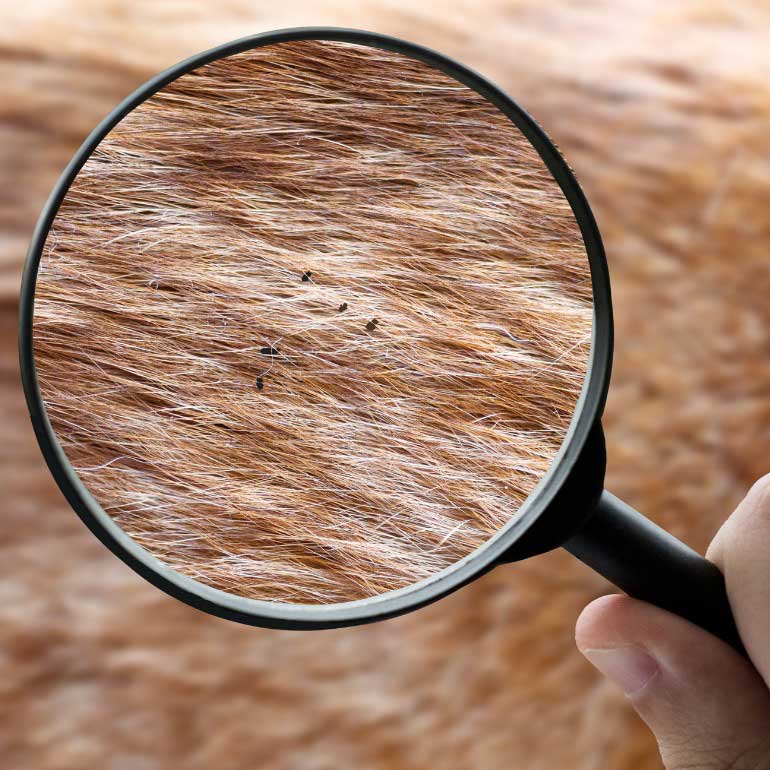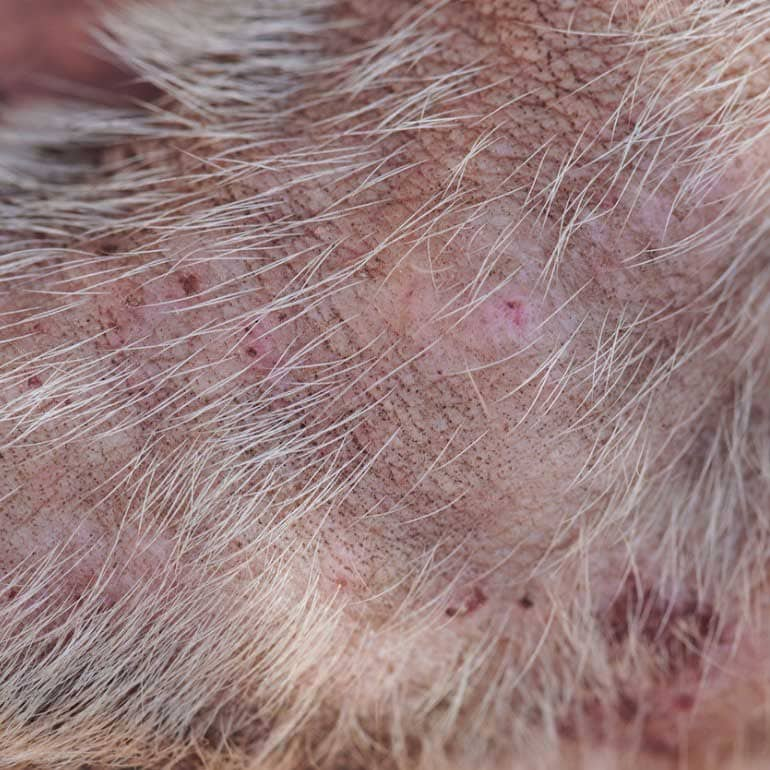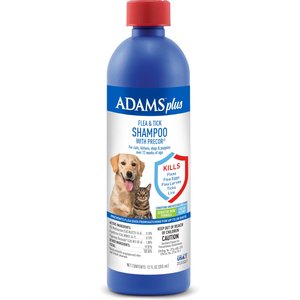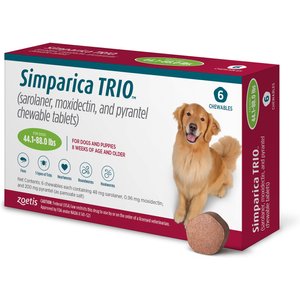So, you think you just found fleas on your dog or cat. It’s essential to take action—and fast. We know detecting fleas on your pet can be an icky experience, especially since there are likely more of them inhabiting your pet’s fur—and areas in your home—incognito. The good news? With the right supplies, you can keep your pets and home flea-free.
Read on to find out how to spot signs of fleas, how to treat a flea infestation and how to prevent one from happening in the first place.
In This Guide
What Do Fleas Look Like?

Not sure if that speck you found on your pet or in your home was actually a flea? Here’s how to know if what you’ve found are fleas:
- They’re small. Fleas are itty bitty, wingless insects that are 1-2mm long.
- They're darker in color. Fleas are generally reddish-brown or black.
- They’re oval-shaped. Fleas are oval-shaped, similar to ticks. (Although, ticks are larger.)
- They can most often be found on your pet’s lower back near the base of the tail. Other common areas on cats and dogs include the neck and belly.
- They like to jump. Fleas can’t fly since they don’t have wings. However, they can jump—high.
What Do Flea Eggs Look Like?
While we wish we could find just a single flea, get rid of it and call it a day, the reality is fleas multiply rapidly. (A female flea can lay up to 50 eggs per day!) One of the keys to putting a stop to fleas is spotting and eliminating flea eggs.
Here’s how to know if what you’ve found are flea eggs:
- They’re incredibly small. Flea eggs are around 0.5mm in length, making them hard to spot with the naked eye.
- They look translucent. Flea eggs are a light, off-white color, making them difficult to see against light-colored surfaces,
- They’re oval-shaped. Flea eggs can look a lot like salt due to their shape, color and size.
- They can be found anywhere. “Fleas lay their eggs on their host animal, but the eggs are not sticky like some parasites, and they can often—and usually—fall off the host,” says Dr. Patrik Holmboe, DVM, and head veterinarian for Cooper Pet Care in Amsterdam, North Holland, Netherlands. “This means they can be found anywhere in the environment, but often where the animal spends time, such as bedding, carpets, or furniture.”
In the flea life cycle, there are two additional stages of development before a flea becomes a egg-laying, blood-sucking adult: larva and pupa. Here’s how to spot them:
- Flea larvae have a tiny, worm-like appearance and are 1-2mm long. Larvae have no legs, are covered in short hairs and are typically an off-white color.
- Flea pupae are 2-3mm long and encased in a silken cocoon, which can be covered in debris from the environment, making them well camouflaged, Holmboe says.
What Does Flea Dirt Look Like?
Where there are fleas, there’s flea dirt … aka flea feces. (Gross, we know!)
Here’s how to know if what you’ve found is flea dirt:
- It looks like, well, dirt. Flea feces is essentially dried blood meal that fleas excrete after they’ve fed on the host. Flea dirt looks like small, dark brown specks or grains, resembling ground black pepper.
- It’s on your pet or in your home. The most common places to find flea dirt are the same places fleas themselves are most commonly found (e.g. on your cat or dog’s bedding, and the furniture).
- It leaves a stain the color of dried blood. “A classic, common way to confirm the presence of flea dirt is to place the suspected specks on a damp, white paper towel,” Holmboe says. “If it is flea dirt, it will dissolve and leave red or brownish stains due to the blood.”
Learn more about flea dirt and if it’s harmful to humans.
What Do Flea Bites Look Like?

Checking your pet for flea bites can also confirm whether you’re dealing with blood-sucking nuisances.
Here’s how to know if what you’ve found are flea bites:
- They’re red bumps. Flea bites can be uncomfortably itchy and may become swollen. The skin may also become red and inflamed, either due to your dog’s scratching or biting at the site, or because of an allergic reaction to the bite.
- There’s a group of small, itchy bites. Flea bites are often arranged in small clusters or lines.
- They show up anywhere on your pet’s body. Fleas will bite anywhere and everywhere on your cat or dog’s skin.
There are different species of fleas—the most common are cat fleas (Ctenocephalides felis) and dog fleas (Ctenocephalides canis), which despite their names can infest both dogs and cats, as well as humans. But both species’ bites look the same, and both can cause similar symptoms of flea-allergy dermatitis (e.g. intense scratching or biting, hair loss, scabs). In some cases, a pet may develop flea anemia with signs of pale gums, lethargy and loss of appetite.
“It's important to note that individual animals—and people—can have varying degrees of reaction to flea bites, with some showing significant allergic responses,” Holmboe says. “Because of this, two animals can have very different symptoms from fleas, even if in the same environment.”
I Found Fleas—Now What?
Finding fleas on your pet and in your home can feel dreadful. After all, who knows how many of these little nuisances have made an all-you-can-eat buffet out of your pet’s blood and have burrowed in the living room carpet? It can feel like an uphill battle, but fear not: There’s a proven process to get rid of fleas for good.
Here’s how to get rid of fleas:
- Comb your pet with a flea comb. Thoroughly comb your pet’s fur to remove fleas. Once your comb has picked up fleas, place the fleas in a bowl of isopropyl alcohol to kill them.
- Give your pet a flea bath with a gentle shampoo. Wash away flea eggs, larvae and pupae in a bath with pet-specific shampoo.
- Use a flea/tick prevention treatment. A popular flea myth is that fleas are only a problem during warmer months. Fleas can stick around (in your home) during the colder months, too, which is why treatment is necessary year round. Note: Do not administer a flea preventative immediately after shampooing your pet with flea shampoo to avoid overdosing your pet on flea-killing medication. Consult your veterinarian to find out when and how to give their preventative.
- Treat your home. Vacuum carpets, rugs and upholstered furniture regularly to remove flea eggs, larvae and pupae, Holmboe says. “Washing your pet’s bedding and toys in hot water can also help eliminate fleas in various stages of their lifecycle.”
- Treat your yard. Spray your yard with pet-safe insecticide. Remove all pets before spraying grass and plants; let the insecticide dry; and supervise your pets to ensure they don’t eat the sprayed areas.
- Repeat all of the above. Repeat the above steps every 3-4 weeks for the next 3-6 months, or until you no longer see fleas on your pet.
How to Prevent Flea Infestations
If you’ve ever been through a flea infestation, you know you never want it to happen again. Luckily, there are a few methods that can help prevent the pests from returning.
The following forms of flea treatment can prevent infestations:
- Oral medications. Prevention can come in a chewable tablet, making it easy to keep up with your dog’s flea and tick treatment.
- Topical treatments. Spot treatments are fragrance-free serums applied to your pet’s skin that provide protection for one month. When applying topical treatments, bathe your pet before the topical treatment or wait at least two days after applying it before giving them a bath.
- Flea collars. A single medicated collar offers protection for up to several months at a time.
- Treatments for the home. From sprays and powders to plug-ins and glue traps, there are various ways to eliminate fleas from your home.
- Treatments for the yard. Fleas like temperate, shady and soily environments. By maintaining and treating your yard with your choice of lawn spray, your dog can potty and play outside without picking up unwanted hitchhikers.
Holmboe adds that regularly checking your pet for fleas and flea dirt, especially if they have been interacting with other animals or have been in an environment known for fleas, can help prevent an infestation. The earlier you catch the pests, the less time they’ll have to multiply.
When using any form of regular treatment (e.g. oral medications, topical treatments or flea collars), Holmboe recommends following the manufacturer’s instructions and consulting with your vet to choose the right product. If used properly, he says commercial flea control products nearly eliminate the potential for flea infestations.
Find out more about the best flea and tick preventatives for dogs and cats to determine the most suitable option for your pet.
Kick Those Fleas Out
Share:












